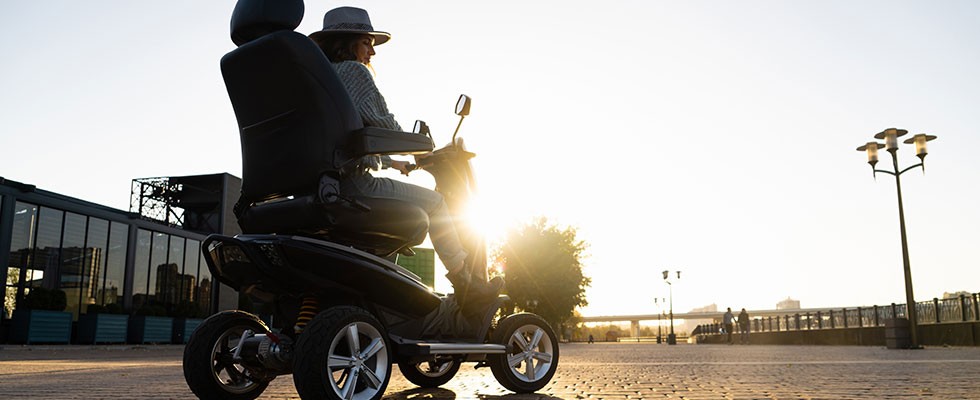
The mention of COVID-19 in 2022 might summon an “ugh” from most of us. While the pandemic has been a long, difficult journey for the entire world, one positive outcome is that people are now eager to leave their homes and regain their former activity.
Visiting with friends, dining out, catching the latest movie in a theater and even nonessential shopping are things many took for granted prior to the pandemic. They are a welcome return (when done safely, of course, following local health guidelines).
For those with limited or decreasing mobility, getting back out there can be challenging. Remember, some people with mobility issues already weren’t leaving their homes much before COVID-19 hit. Many of these people also have a renewed interest in being active.
High Demand
Enter the increased demand for mobility products. Mobility products were already in high demand due to aging baby boomers wanting to maintain active lifestyles. As the population gets older, this trend is expected to continue. Now, with even more people wanting to leave the house and explore, the demand for scooters and power wheelchairs is greater than ever.
Durable and rugged scooters and personal mobility vehicles are the perfect solution for someone who wants to spend a lot of time outdoors, especially if they will be on varied terrain such as grass, gravel and dirt. They are ideal for people who own a larger property or who spend time in fields and wooded areas. These scooters usually have a larger foot platform, higher maximum speed and range, and bigger tires. Larger scooters and personal mobility vehicles also tend to have a higher weight capacity and more features than travel scooters.
Travel scooters are great for people who also want to go places but do not have a vehicle lift. While travel scooters certainly do work well with vehicle lifts, they are primarily designed to be easy to take on trips—and that might be anywhere from a granddaughter’s soccer game that’s just a few miles away from home to international destinations.
Power wheelchairs are helpful for people who need assistance with mobility and lack good upper body dexterity, which makes it difficult to operate a scooter. A power wheelchair has a joystick for operations. However, just like scooters, power wheelchairs also come in several options, such as heavy-duty or lightweight for travel.
Additionally, as nursing homes continue to close and patients move in with family, they may have a change in eligibility. Many who no longer live at a skilled nursing facility now qualify for scooters and Group 2 power wheelchairs. These patients will need to be mobile in their new homes to independently accomplish activities of daily living such as getting a drink of water in the kitchen or making it to the bathroom to use the toilet.
Increasing Innovation
Today’s mobility products need to be dependable and feature rich since so many different people are using them for a variety of reasons in numerous environments. This has led to tremendous innovations in power, torque, speed and more.
Smaller Turning Radius/Narrower Width
Whether someone is using a van ramp to access a vehicle or turning in a tight area such as a restroom stall, the need for narrower width and a smaller turning radius is greater than ever. The ability to navigate small spaces is critical for many people who use mobility products.
Battery Range
End users want a reliable battery range so they don’t need to worry about charging when out and about. There is a demand for a range per charge that will last a full day at a theme park or when exploring a city. No one wants to get stuck somewhere with no power left on their mobility product.
Power Seat Elevators
Power seat elevators on power wheelchairs can provide extra height and put the user at the same height as their peers. This allows for eye-to-eye communication. Aside from social advantages, this also provides added functionality by allowing access to upper cabinets, countertops, clothing racks and much more. The list of functionalities is long, and it helps end users accomplish daily activities of living independently. It also can be helpful when crossing a street or in a parking lot by making the person more visible to vehicles.
Folding
As more and more people with limited mobility travel, they are looking for products that will take up the least amount of space when stored or in transit. Having the ability to easily fold and unfold a product is important to its usability.
Aesthetics
Appearance has improved in cars, computers, etc. over the years, and it is also improving in mobility products. Consumers don’t want the bulky products of the past. Today’s mobility products need to have a sleek, stylish and sophisticated look.
Accessories
As more technology becomes available, end users want even more accessories. At one time, a cup holder or safety flag were often the only standard items. Now there are many, including cellphone holders, USB charging ports, full LED lighting, a wider color selection and more. Accessories help consumers personalize their mobility product to their needs and lifestyle.
Changing the Mobility Industry
While the COVID-19 pandemic brought so much tragedy to the world over the past two years, many people have a renewed sense of life and are ready to leave their homes more often. Looking ahead, the demand for mobility products is expected to continue to increase as the world has more senior citizens than ever. With that will come a need for further product development and innovation. No one can see the future and know for sure where the industry will be in 10 or 20 years, but we do know one thing: Technology will continue to advance, and people will live longer. This will propel the industry forward, bringing the hottest, most innovative products to market.
